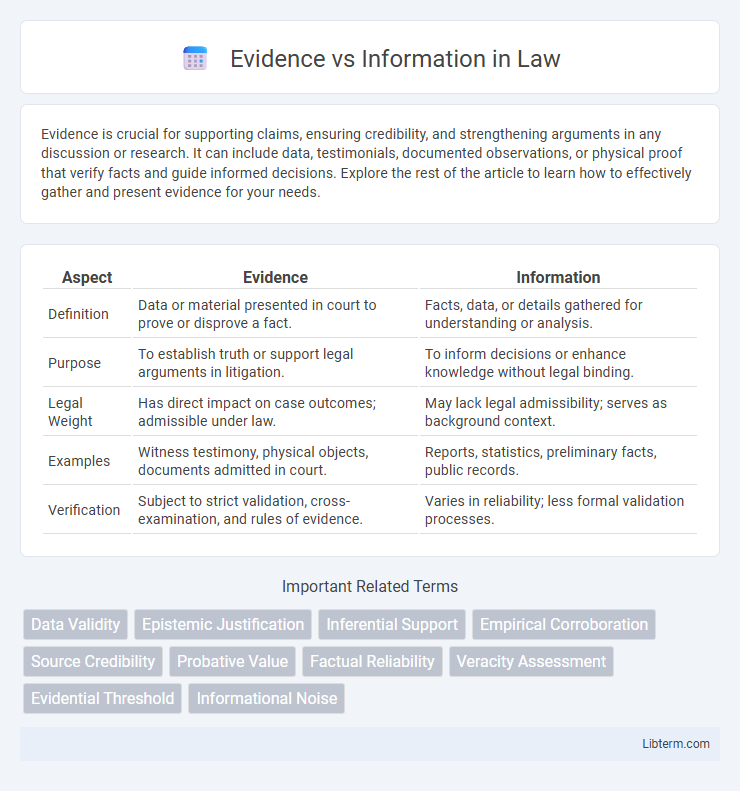Evidence is crucial for supporting claims, ensuring credibility, and strengthening arguments in any discussion or research. It can include data, testimonials, documented observations, or physical proof that verify facts and guide informed decisions. Explore the rest of the article to learn how to effectively gather and present evidence for your needs.
Table of Comparison
| Aspect | Evidence | Information |
|---|---|---|
| Definition | Data or material presented in court to prove or disprove a fact. | Facts, data, or details gathered for understanding or analysis. |
| Purpose | To establish truth or support legal arguments in litigation. | To inform decisions or enhance knowledge without legal binding. |
| Legal Weight | Has direct impact on case outcomes; admissible under law. | May lack legal admissibility; serves as background context. |
| Examples | Witness testimony, physical objects, documents admitted in court. | Reports, statistics, preliminary facts, public records. |
| Verification | Subject to strict validation, cross-examination, and rules of evidence. | Varies in reliability; less formal validation processes. |
Defining Evidence and Information
Evidence refers to concrete, verifiable data or material presented to support or refute a claim, often used in legal, scientific, or investigative contexts. Information encompasses processed and organized data that provides meaning, context, or understanding but may not directly prove a hypothesis or assertion. Distinguishing evidence from information is critical in ensuring that conclusions are based on substantiated proof rather than mere data or general knowledge.
Key Differences Between Evidence and Information
Evidence refers to data or facts that support or refute a particular claim, hypothesis, or argument through verifiable and objective means. Information denotes processed or organized data that provides context and understanding but lacks the direct, demonstrable link to prove or disprove a specific assertion. Key differences include the purpose, reliability, and application: evidence is evidence-based, objective, and used to validate conclusions, while information is broader, may be subjective or interpretive, and serves to inform or explain.
Types of Information in Research
Types of information in research include primary, secondary, and tertiary sources, each serving distinct purposes in data collection and analysis. Primary information consists of original data obtained through experiments, surveys, or observations, offering direct evidence to support hypotheses. Secondary information involves the evaluation of primary sources, such as literature reviews and meta-analyses, while tertiary information compiles and summarizes these findings, including encyclopedias and textbooks.
Characteristics of Reliable Evidence
Reliable evidence is verifiable, objective, and consistent across multiple sources or observations, ensuring its credibility and accuracy. It is specific, directly relevant to the claim or hypothesis, and obtained through systematic methods such as experimentation or documented procedures. High-quality evidence maintains transparency, can be independently reproduced, and is free from bias and manipulation.
The Role of Context in Interpreting Information
Context shapes the interpretation of information by providing the circumstances and background necessary to distinguish evidence from mere data. Evidence is information that is relevant and meaningful within a specific context, supporting conclusions or decisions through its reliability and applicability. Without context, information lacks the framework to be assessed for validity, making the understanding of evidence dependent on its situational relevance.
Sources of Evidence in Various Fields
Sources of evidence vary significantly across fields, such as scientific research relying on experiments, observations, and peer-reviewed studies, while legal cases depend on witness testimony, documents, and physical artifacts to establish facts. In healthcare, clinical trials, patient records, and diagnostic tests serve as primary sources of evidence to guide treatment decisions. Historical research utilizes archival documents, oral histories, and archaeological findings to reconstruct past events accurately.
How Information Becomes Evidence
Information becomes evidence when it is relevant, reliable, and directly supports a claim or hypothesis in a specific context. The transformation occurs through processes such as validation, verification, and proper documentation that establish authenticity and connection to the subject matter. Only then can information be analyzed systematically to serve as credible proof in decision-making, legal proceedings, or scientific research.
Challenges in Distinguishing Evidence from Information
Distinguishing evidence from information poses challenges due to the nuanced criteria that define evidentiary value, such as relevance, credibility, and context specificity. Information may lack direct applicability or verifiability, complicating its transformation into reliable evidence for decision-making or legal purposes. Cognitive biases and the abundance of data further blur the boundaries, increasing the risk of misinterpretation or misuse in analytical processes.
The Importance of Evidence in Decision-Making
The informal sector often lacks legal protections, social security, and minimum wage guarantees, exposing workers to exploitation and poor working conditions. In contrast, the formal sector provides regulated employment with enforced labor laws, social benefits, and access to healthcare and pensions, promoting worker stability and well-being. The disparity significantly impacts social equity, as informal workers face higher vulnerability without formal rights or institutional support.
Evaluating Information for Evidentiary Value
Evaluating information for evidentiary value requires assessing its relevance, credibility, and authenticity to ensure it can support a claim or argument effectively. Evidence must be verifiable, factual, and directly related to the issue at hand, distinguishing it from mere information which may lack these attributes. Reliable evaluation tools include source analysis, corroboration with other evidence, and validation through expert testimony or documented proof.
Evidence Infographic

 libterm.com
libterm.com